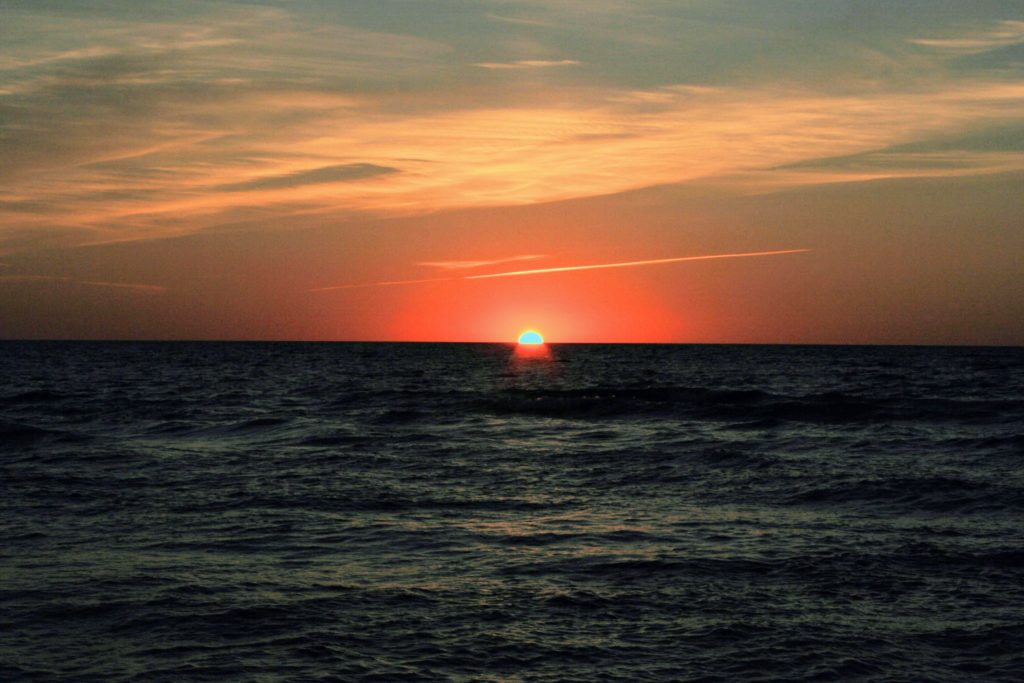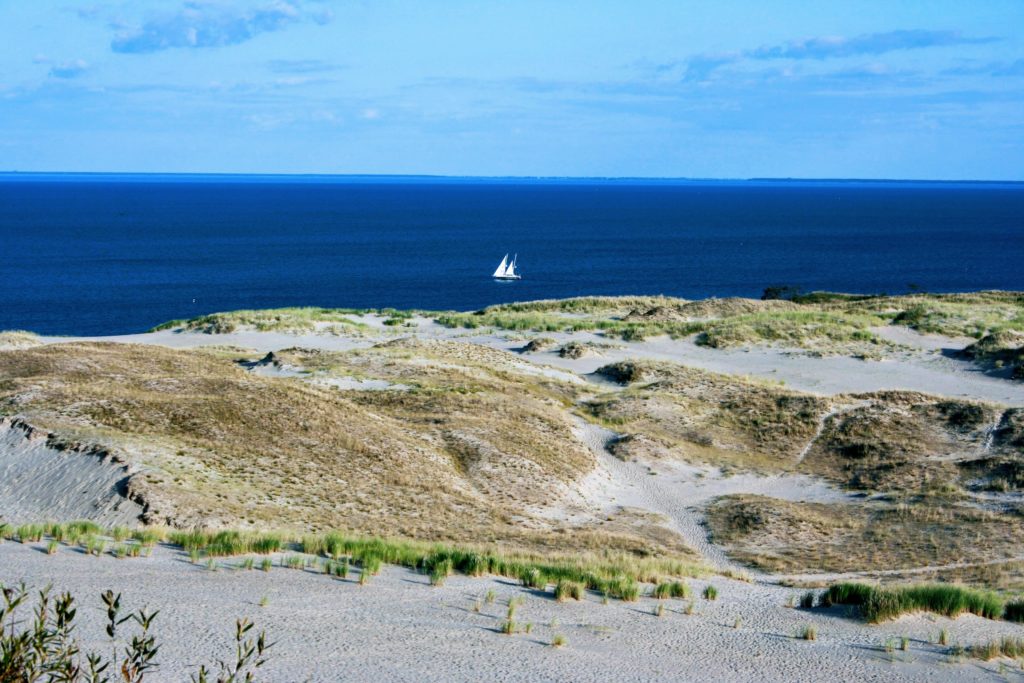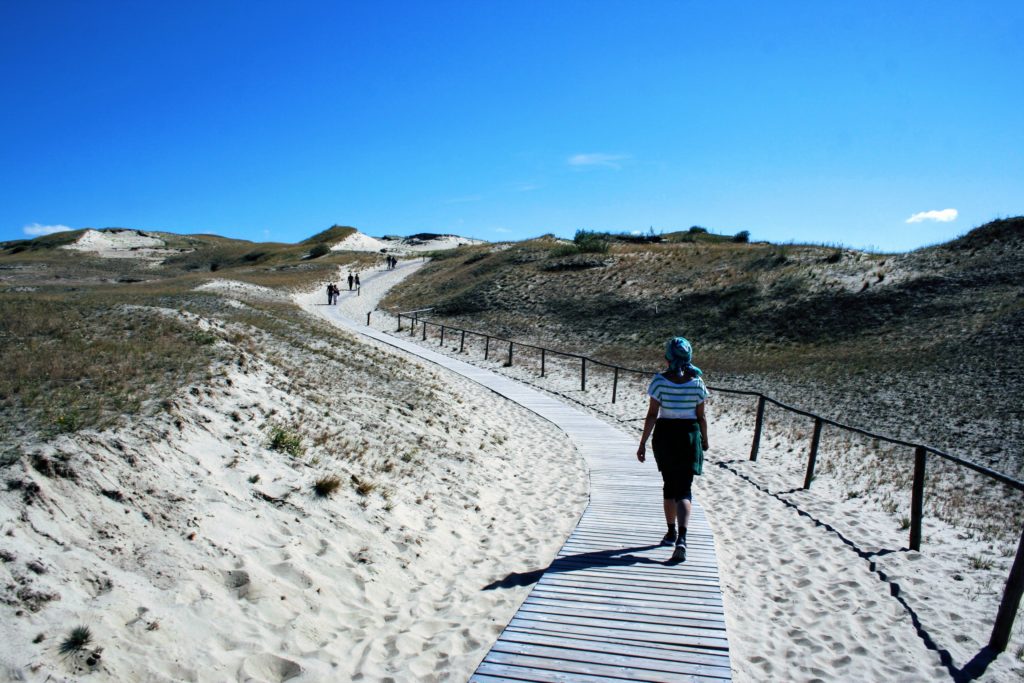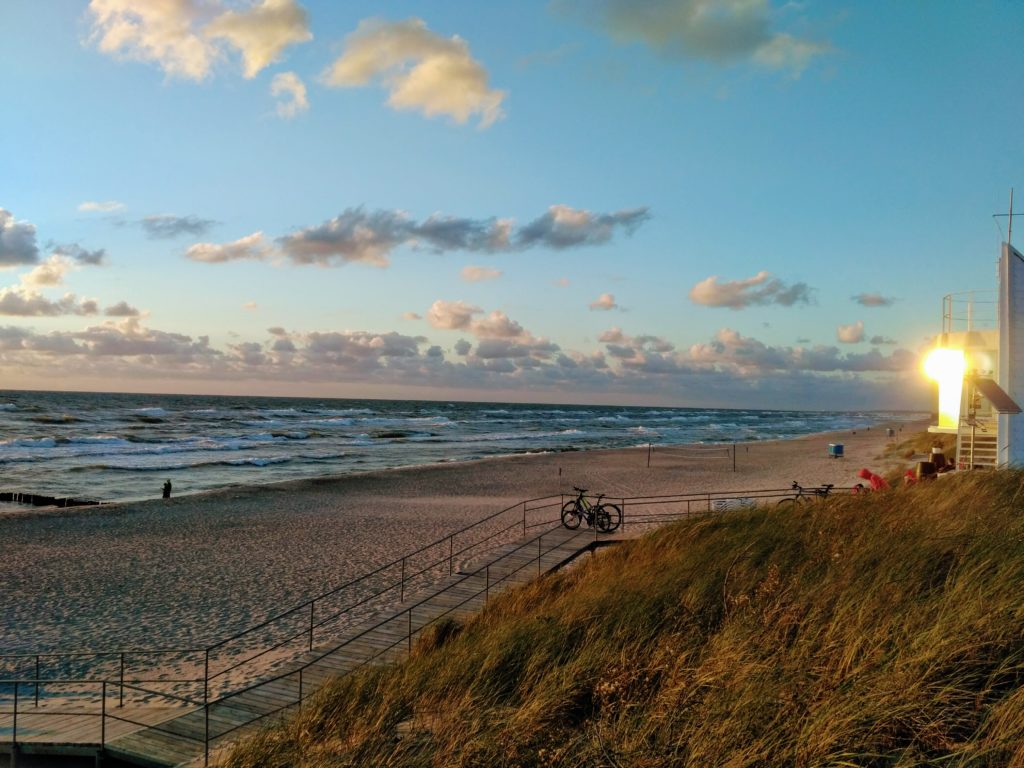There are places I remember all my life
Though some have changed
Some forever, not for better
Some have gone and some remain
Well well, you know how it goes. In my love I liked them all, but if I have to chose one I loved the most, I would chose the Curonian Spit in the Baltic Sea. And there are so many reasons for this that I am struggling where to begin.
Just a brief introduction of what the Curonian Spit actually is. It is an almost 100 km long 3-4 km wide thin strip of land in the Baltic sea. Half of it belongs to Lithuania, and another half to Russia. In this post I will only touch the Lithuanian part.
Before we begin, let me tell you that I put those to-do’s in no particular order. For me it would be a torture to be forced to decide, which is the best thing to do on the Curonian Spit, and which one is the second best. They all are awesome. The grade of awesomeness only depend on your interests and likes, as well as the weather or your mood on a particular day.
Table of Contents
- 1 Catch the sunset
- 2 Climb the Parnidis Dune
- 3 See the Dead Dunes
- 4 Visit Thomas Mann House and Museum
- 5 Explore the Hill of Witches
- 6 Watch the sunrise over the Curonian Lagoon
- 7 Eat smoked fish in the dunes
- 8 Go cycling or trailing through the spit
- 9 Check out cormorant colony near Juodkrante
- 10 Swim and build a sand castle
Catch the sunset
The absolute classic! The location of the Curonian Spit in the world specifically makes it one of the best sunset cinemas in the world. Lithuania is a northern country, so the sunsets here are much longer than the ones in the south. I tried those and was disappointed with this fast-forward speed.
Of course in order for you to witness this beauty, the sky has to be clear. If it is a warm summer evening, you can also go for a swim in the water. It is an unforgettable experience – walking straight into that path of light on the water. You will feel as if you are swimming in the liquid gold.

If it is a colder (or in other words – regular) evening, do not forget to grab some extra clothes with you. Usually it gets windy and even chillier during and after the sunset.
Insider’s tip: Get some smoked fish, rye bread and local beer (some of the non-alcoholic ones are also great), dress well and get a blanket. The best spots are not directly on the beach, but up on the dune. This way you can have a great view, some privacy and also be shielded from the wind, if it’s windy. Chin-chin! This is one of the greatest views you are going to have alongside your meal.
Climb the Parnidis Dune
Parnidis Dune is located just outside Nida. Well, at the moment, as this dune has changed its location throughout the history. The wind blows the sand, and the dune moves, sometimes swallowing the whole settlements or fishermen villages. Of course, the speed of this movement is very slow and the village dwellers have the time to prepare and move away. Still, I find the whole idea of moving sand hills fascinating and a bit disturbing.

The dune is 52 m high, and you can see both the Baltic Sea and the Curonian lagoon from its top. Right on the top of the dune, next to the view point, you will see the sun clock.
You can walk on and around the dune, but please respect the signs, allowing or not allowing to go to some specific parts of it. There are plenty of spaces to roll down the sand, explore and take desert-like pictures. The no-access areas are not there just for the sake of it – they are needed to protect the dune and keep it in one piece (and place!).
Insider’s tip: Take a 1.8 km walking trail around the dune. Watch the border control ships in the lagoon. Right after the Parnidis dune the borderland between Lithuania and Russia starts, so if you do not have your passport and visa with you, do not walk too far into it.
See the Dead Dunes
Speaking of dunes, there are more of them for you to see on this trip. Does the name of Dead Dune sound intriguing enough?
The Dead Dune, Naglis Dune or Grey Dune (all the same dune, just many names) is located between Juodkrante and Pervalka. Whether you are travelling by car or by bike, watch for the sign announcing Naglis Nature Park. There is a path, which will take you all the way up to the top of the dune. From there you can see the Curonian Lagoon in front of you and vast hills of sand to your both sides.

While standing on the dune, keep in mind that somewhere below under your feet there is a couple of villages. The dune moved and buried the villages of Nagliai and Karvaiciai (or Karwaiten). Only years later the newer villages of Pervalka and Preila were built.
While exploring the Dead Dune, stick to the path and the view point and avoid walking away on the unprotected areas. Deserted as it may seem, the area is often checked by the guards and intruders can be fined.
And why is this dune called the Dead dune? This is actually one of those rare cases, when dead is good. A dune which is alive would still be moving and swallowing settlements (now including all those fancy property developments, which would really be a bad business). A dead dune stays in one place.
Insider’s tip: So, you are only allowed to stick to the path and even that is actually considered harmful for the dune. A better idea might be to take a boat from Nida or Juodkrante and see the Dune in all its beauty from the water. Check the boat terminals in Nida and Juodkrante. During the high season you would normally have one or two boats a day doing this trip.
Visit Thomas Mann House and Museum
Did you know that Thomas Mann, German writer and Nobel laureate, had his summer cottage in Nida? He spent a couple of summers there, before the Nazi regime made him leave Germany in 1933.
He first visited Nida in 1929. According to his essays, was “so impressed by the inexpressible beauty and uniqueness of its surroundings”, that he decided to have a house built there. You can still see this house, built in typical regional fishermen house traditions. It was repaired several times and has been preserved to look as much as possible the same way as when it was still Thomas Mann’s summer residence.
The House is currently turned into Thomas Mann Culture Centre and Museum.
Insider’s Tip: Visiting the museum might be a great plan for a rainy day (or a too sunny day… or any day really). Check the website before going, as there might be some interesting stuff going on, like special readings, Thomas Mann Festival, a conference or a seminar. By the way, while writing this I realised I managed to take no pictures of the Museum. And if the rain persists, continue your educational programme by visiting Nida Art Colony.
Explore the Hill of Witches
The Hill of Witches is located on the outskirts of Juodkrante. The hill is basically a big sand dune covered by forest with many wooden sculptures of witches. The legend says that in the old days the witches loved to gather on this hill at night to dance until the dawn. Later some people followed this tradition and chosen this hill as a place for midsummer celebration.

The first sculptures started appearing in 1979, when the forester Jonas Stanius decided to honour the witches and invited a group of artists to make the first sculptures. The “population” of witches continued to grow since, at the moment reaching 80 sculptures.
The hill is divided in two parts: the Light and the Dark. The Light part is – logically – light and has big paths. There you will find the brave and romantic heroes and heroines of Lithuanian legends. But try walking further and the path will narrow, entering the Dark side. In this part you will find dragons, devils and witches. And on the very end of the path you will meet a rooster, announcing the end of the night and scaring all the creatures away.
Insider’s tip: When you find yourself on the very top of the hill, take your time and look around. You can see the Baltic sea on one side and the Curonian lagoon on the other side.
Watch the sunrise over the Curonian Lagoon
Did I say that the sunset was my favourite? But if I’m really forced to choose between the sunset and the sunrise, I would chose the sunrise. It is just so painfully difficult to get up to watch it, especially in June-July, when the sun rises as early as 4-5 am.

But this is the most beautiful sight. In most villages you would find a path by the lagoon and some benches. You can sit on one and watch the sun slowly rise above the lagoon. If the day is clear, this is a sight difficult to forget. All the colours change and the water turns gold. The air fills with so much energy and promise that this day will be absolutely special.
Insider’s tip: Although if you look at the photos later, they will be rather similar to the ones from the sunset, it is exactly this promise which will make all the difference. Try and force yourself out of the bed just once! Even better – watch the sunset, stay up, enjoy the sounds and smells of the night outside and then enjoy the sunrise.
Eat smoked fish in the dunes
Before becoming a tourist destination, the Curonian Spit was first and foremost a heaven for the fishermen. One one side you would have the lagoon, where most of the fish is coming from, and on the other side – the sea.

At the moment there are still many fishermen, who preserved the craft. The fish would be fresh smoked using old-fashioned smoking equipment. You can get it in any village on the spit, just look for “Rukyta zuvis” (“Smoked Fish”) signs on the houses. Probably every person going to the spit for holidays more or less regularly would have her or his own favourite spot with absolutely best fish.
Insider’s tip: If you are in Nida, try “Tik pas Jona” (“Only at Jonas’”). It is probably the most established place you can get your fish from. The best is to just get it as a take-away, get some bread and fresh cucumbers on the way and have a picnic in the dunes or in the pine forest.
Go cycling or trailing through the spit
It is a heaven for not-too-well-trained cyclists. The length of the Lithuanian part of the spit from Smiltyne until the border with Russia just after Nida is roughly 50 km. You will have a cycling path all throughout the spit. The path is very well-maintained and has signposts along the way, so you will not get lost.

The path goes mainly through the centre of the spit between the sea and the lagoon. If you want to visit the villages specifically or have a swim in the sea, you would need to take a connecting side path to the either side. Most of the distance you would cycle through the pine forest, but you also will see some fields, plains, dunes on your way. The path is not too challenging even for a beginner, but not completely flat.
If you are not too much into cycling, you can also walk on the same paths or chose many others on the spit.
Insider’s tip: I tried both cycling and walking on this path and enjoyed both a lot. Disregarding whether you chose feet or wheels, you would still have experience, which you would otherwise have missed taking a car or a coach. The pine forest is unique and the trees look like overgrown bonsai trees. It also has a smell of its own – one of my favourite ones in the whole world. This smell will also have so many different notes depending on the time of the day and the day of the year. A hot sunny day and a damp autumn morning will have a tone of their own, making it worth coming and exploring this place again and again.
Check out cormorant colony near Juodkrante
A rather tragic story of an opposition of grey herons and cormorant birds. Grey herons were typical for Lithuania since at least 19th century and possibly even earlier. The cormorants are the new arrivals. They were hardly known in Lithuania until 1978, until suddenly a couple of waves of them came here. The cormorants decided to settle on the hill just outside Juodkrante and pushed the grey herons, who occupied this location since the old days.
On this hill, now called Heron Hill, there are currently around 2000 cormorant pairs and 500 heron pairs. The cormorants are clearly winning this battle, outnumbering the herons. What is even more interesting – destroying the forest in which they live. If you go to the hill, you will easily find the location of the colony, because the trees there are all absolutely naked and dead. But not only the foresters are unhappy by this invasion. The fishermen blame cormorants for the reduced catches.
There is however no way to stop the cormorants at the moment as they – although in this particular location they may seem very strong and destructive – are endangered birds and protected by law.
Insider’s tip: Hey, what tip can I give you about the cormorants? I’m not an ornithologist. Do not mess with them!
Swim and build a sand castle
Obvious as it may seem. The Curonian Spit has amazing beaches. It actually does not matter which village you chose as your base. All of the beaches are similar in their awesomeness. You will find a broad beach of soft white sand and a strip of dune, where a kind of natural nests are formed. Chose those nests, if it is too windy by the sea, as they are protected from the wind.

The Baltic Sea is rather warm, and your usual “good” temperature in summer would be +18 degrees Celsius. On a bad day you might have to have a refreshing swim in 14C. If you are extremely lucky, the water temperature might go up til 22C. But if you manage to survive this and not have pneumonia, then probably this water will be good for you and will make you a stronger human being. And it is handy indicator, showing when it is the time to take your child out from the water – their lips will go blue. This is actually not a joke, it is a true fact and can be confirmed by anyone, who spent their childhood in Lithuania.
Insider’s tip: If you are staying in Nida or Juodkrante during the summertime, look for the ads for beach yoga. The sessions usually takes place in the morning and in the evening. It is a great way to warm up before your swim or to spend your time at the beach in a different way.
Liked this post? Pin it!


Very informative post and great tips and post as well.
Thanks Radif!
Interesting post!
Thank you Steve!
Wow this place looks gorgeous! Especially love the sunset and sunrise pictures. I enjoyed my time in this region and would love to visit more of Lithuania specifically. Now this is on my list!
Thanks for saying that! I’m sure you’ll love it. The sunsets and sunrises are beautiful in any season. I’m actually planning to come later in winter, so I can catch more sunrises – they will be late in winter, around 8-9 am instead of 4-5 in summer. 🙂
Lovely to read about somewhere different. Put on the list for next year’s tour. Thank you. Kx
I’m so happy I made you want to visit it. That was the whole purpose of this post! 🙂 I am planning to write more about practicalities later, will share that.
This area of the world has been on my radar. Will definitely have to check this place out when I get there. I love sand dunes!
For a dune-lover it is a must-visit, that’s for sure! I will write more about getting there, places to stay and logistics.
Wow beautiful photos! I am looking into visiting Lithuania and will add this to my list 🙂
Thank you Alex! Lithuania is a bit undervalued as a destination, and people usually go to Vilnius only, when they come here. However, this Spit might be even more worth a visit.
Wow there is so much nature to enjoy in the Curonian Spit! I hope to make it here someday so I can enjoy it all. It looks very relaxing.
True, there is a lot to see there! It is a very small piece of land, but also one of the most beautiful places I have ever seen!
Nida and the whole Curonian Spit is my absolute favourite place in Lithuania too! I spent so many summers there as a kid, but haven’t been back for almost 15 years now. Hoping to take my kids there next summer, and your post just confirmed that it’s the right decision. I know I will love going back, and it will be interesting to see how it has changed over the years.
I’m glad you liked it! It does change, but very very gently. The houses are repaired, some new things pop-up, but blend in very well. So in a way I feel that it is the same it has always been since my childhood.
If these are the sunsets you saw, I can’t say I blame you! How romantic!
It is!
Beautiful photos!!! No wonder you parked up.
Thank you Catherine!
thanks for the tip, I love doing yoga by the beach and will certainly look up to that. I love your photos as well.
I actually not much into yoga myself, but to me this is one of the most suitable places for that. It is just so peaceful.
I went there too. Cycling is relaxing even with children, as the path are mainly for bikes only. Would love to go there soon again.
Great post, definitely putting Lithuania on my hit-list! Beautiful photos ?
Great tips to follow! Would love to swim one day on that stretch of liquid gold!
Thank you! And I hope this day is soon.
Those dunes look amazing. As I was reading I kept on asking: but why are they called the Dead Dunes? I’m glad you answered that for me ? I watched a documentary about alive dunes once. Really cool!
😀 Great, I wasn’t sure people would be interested in it. But yes, I found it interesting myself.
Your pictures look amazing! Would you recommend renting the car to go to Curonian split from Klaipeda so you can drive to different villages? Or did you walk/bike after you get off the ferry?
Thank you! I definitely do not recommend getting a car. It’s more of a nuisance and extra cost than it is of help. Parking is expansive and rather limited, and you will pay for the ferry and the entrance to the national park by car. Also, during the high season there can be very long queues to get to the ferry by car.
Curonian spit has very good public transport, so you can easily use buses between the villages. It also has excellent bike paths, so this is another option. Or you can combine both, as most buses take bikes too. So you can cycle somewhere and get back by bus.
I tried all the options. We went by car many times in the past with my parents and once with my husband and our toddler. We also cycled a couple of times all the way from Klaipeda to Nida. Once we even walked from Klaipeda station to Juodkrante, but that takes ages 🙂
I can just about taste the smoked fish and smell the pine Forrest all the way from australia